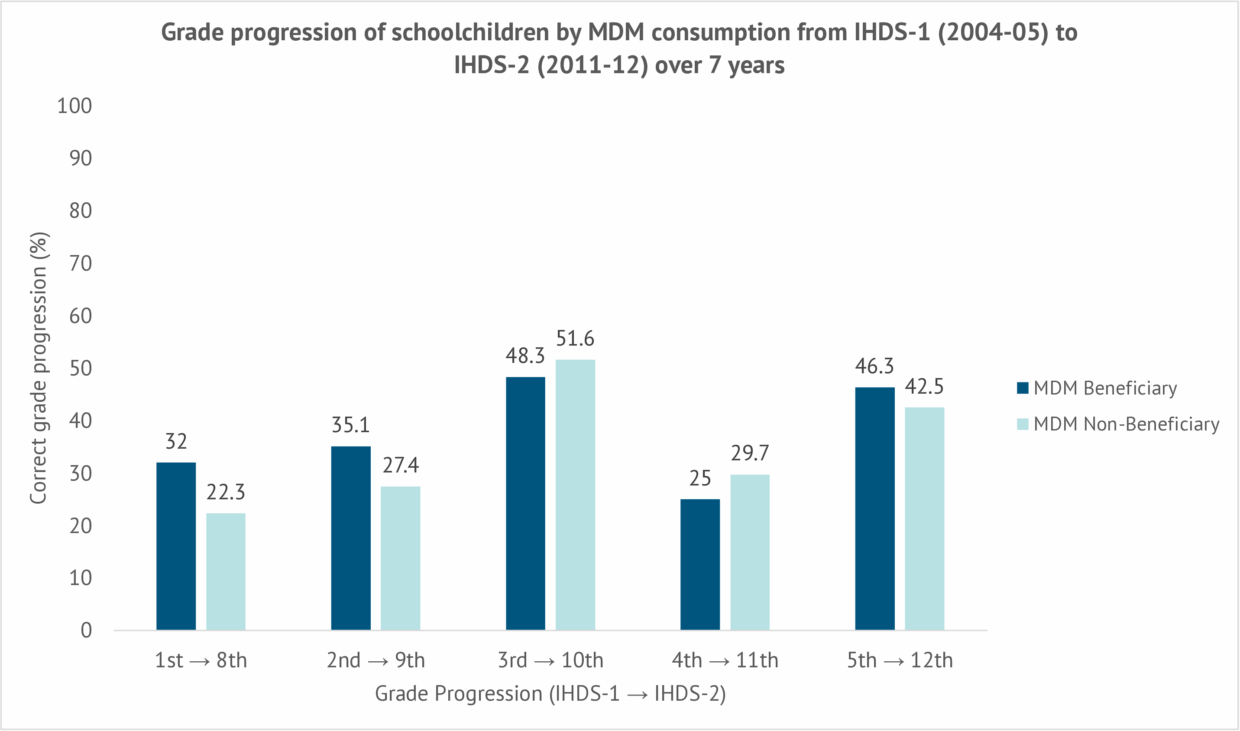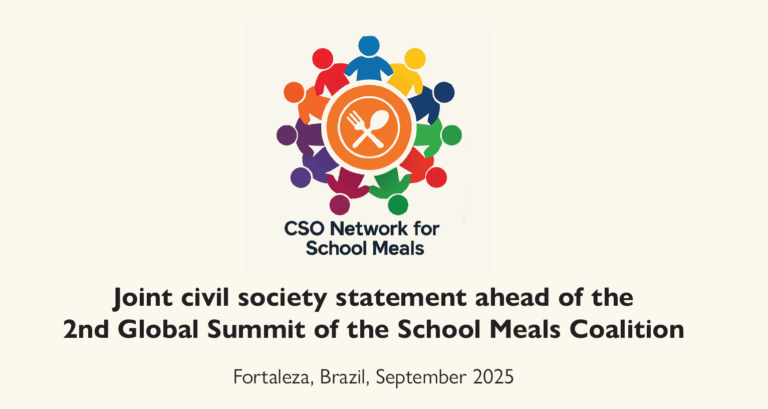
Feeding the Grades - Calling for an Expansion of School Meals in India
Blog by Dr. Shivani Gharge, GCNF Research Coordinator & Dr. Sayeed Unisa, former Head of the Department of Biostatistics and Epidemiology at the International Institute for Population Sciences.
Why do children drop out of school, and what helps them stay? These questions are at the heart of education policy, especially in a country like India, where universal school enrolment and retention remains a significant challenge. The reasons why a child may drop out of school are complex. Many families in India may weigh the cost of keeping a child in school against the immediate need for help at home or extra household income that can be earned from a child’s work.
Many families in India may weigh the cost of keeping a child in school against the immediate need for help at home or extra household income that can be earned from a child’s work.
In an attempt to improve school enrolment, retention, and attendance while enhancing childhood nutrition, in 1995 the Government of India officially launched the National Programme of Nutritional Support to Primary Education (NP-NSPE), widely known as the Mid-Day Meal (MDM) Program. Under the program, every child in all government and government-assisted primary schools are to be served a cooked meal with a minimum of 300 kilocalories and 8–12 grams of protein per day for a minimum of 200 days per year.

Photo submitted by Ashish Bhardwaj, Sri Sathya Sai Annapoorna Trust
The program was further extended to upper primary schools in 2006-07. By 2006, around 120 million students were receiving cooked meals under the MDM program, which is now regarded as the world’s largest school meal program.
This blog article draws on the findings from our recently published study in MARGIN: The Journal of Applied Economic Research, titled, “Dropout and Retention Among School Children in the Context of the Mid-Day Meal Programme in India”. Using nationally representative panel data from the India Human Development Survey (IHDS), our study investigates how school meals have influenced dropout and retention rates among children in India over time.
In this study, we followed a group of 9,818 children (5,068 boys and 4,750 girls) who were enrolled in government or government-assisted schools. Data was gathered when the children were between 5–10 years old during the 2004–2005 school year (IHDS survey round 1) and again when they were between 12–17 years during the 2011–2012 school year (IHDS survey round 2). We analyzed two key outcomes: dropout (defined as a child who was in school during the first survey round (IHDS-1) but was no longer in school by the second round (IHDS-2), and retention (a child in a certain grade during IHDS-1 was to progress to a corresponding higher grade in IHDS-2).
To understand the role of the MDM program, we classified children based on whether they received meals during one or both survey rounds, or not at all. We also considered various background factors, like household size,education of parents/household adults, social group, region, distance to school, and whether children received other forms of support, such as free books or scholarships.
Dropout and retention
The study’s findings show that children who received mid-day meals had better odds of staying in school after 7 years of schooling than those who did not. Moreover, the MDM program was particularly effective when it began in the early years of schooling. Its positive effect on school retention suggests that providing nutritional support early in a child’s education may create a strong foundation for ongoing academic engagement.
Children who received mid-day meals had better odds of staying in school after 7 years of schooling than those who did not. The program was particularly effective when it began in the early years of schooling.
The stage between Grades 5 and 10 is especially critical. It’s a transition point where many students are at risk of leaving school. School meals during this time can make a big difference for them to stay in school. School meals are only provided up to Grade 8. Once the meal support ends, families and students may face new barriers to school attendance, contributing to higher dropout rates. These findings highlight the importance of early and sustained support throughout a child’s school career. Starting nutritional programs early can make a lasting difference, but continuity may also be key to maintaining that progress, primarily through critical school years when dropout risk increases.
The stage between Grades 5 and 10 is especially critical. It’s a transition point where many students are at risk of leaving school. School meals during this time can make a big difference for them to stay in school.
On retention, we found that children who were in Grades 1, 2, and 5 during IHDS-1 that received school meals were more likely to be in Grades 9, 10, and 11 during IHDS-2 (where they would be expected to be after 7 years). However, the positive effect was not as strong for children in Grades 3 and 4 that received school meals. These students had a lower prevalence of reaching the expected grade level after seven years, however, the differences between children receiving meals and those that didn’t were smaller.

Other school related factors
Additional incentives like free textbooks and scholarships were also linked to improved retention among children. Providing free textbooks in government schools is beneficial for the children because high textbook costs can discourage parents from sending their children to school, often pushing them to choose work over education. Scholarships provide financial support and incentives that can be crucial for continuing education, especially for families facing economic challenges.
Participants living more than 1 kilometer from school were more likely to drop out compared to those living within 1 km. Long-distance travel to school negatively impacts attendance and can lead to higher dropout rates. Research has shown that the likelihood of enrolling in or finishing Grade 9 decreases steadily with increasing distance to the nearest secondary school, highlighting distance as a significant barrier to secondary school enrolment. In response to these challenges, India’s Right to Education Act (RTE Act) mandated that ‘neighbourhood schools’ be within 1 km of walking distance for children in Grades 1 through 5 and within 3 km for children in Grades 6 through 8.
Another significant factor influencing school dropout rates was where the students lived. In our research, we found that the likelihood of dropping out of school was higher for children who lived in urban areas. This is often due to the pressure on these children to engage in economic activities to support their families. The need to contribute financially is particularly prevalent in urban areas, where families may face higher costs of living. Moreover, studies have found that the dropout rate among girls in urban areas is even higher than that of boys. This highlights a gender disparity, where girls are more likely to leave school to enter the workforce or take on family responsibilities at an earlier age.
Recommendations
This study highlights a powerful message: India’s Mid-Day Meal program does more than fill empty stomachs — it helps keep children in school and improves educational outcomes. As one of the few national-level evaluations of the MDM program using panel data, this research offers evidence to guide stronger, more targeted education policies. It reminds us that school meal programs are not just welfare initiatives but essential tools for improving educational outcomes, especially among children from lower socio-economic backgrounds.
School meal programs are not just welfare initiatives but essential tools for improving educational outcomes, especially among children from lower socio-economic backgrounds.
These findings could be taken to support a broad focus by the government of India and beyond, thus providing a foundation for potential new policy recommendations, tackling the high prevalence of dropout, and implementing programs in the early years to improve retention among children. The findings from our research recommend that the Mid-Day Meal program be expanded to include children beyond the 8th grade, providing crucial nutritional support and incentivising continued adolescent education.
Additionally, the results of this study are likely to encourage additional research on urban children, school mapping, and provision of free textbooks and scholarships. The broader relevance of these findings could help India’s central and state governments identify regional- and state-specific measures, thereby benefiting educational outcomes and future employment among Indian children and adolescents.
The findings from our research recommend that the Mid-Day Meal program be expanded to include children beyond the 8th grade, providing crucial nutritional support and incentivising continued adolescent education.
About the Authors:
Dr. Shivani Gharge, GCNF Research Coordinator
Shivani joined GCNF as a Research Coordinator in July 2024. She holds a Ph.D. in Population Studies from the International Institute for Population Sciences (IIPS) in India. Her Ph.D. work focused on food intake, physical growth, retention, dropout, and learning outcomes in the context of the Mid-Day Meal program in India and is a co-author of the study, “Dropout and Retention Among School Children in the Context of the Mid-Day Meal Programme in India,” which explores how school meals may influence dropout and retention over time. Shivani also holds an M.A. and M.Phil. in Population Studies from IIPS and a B.A. in Economics from Ramnarain Ruia Autonomous College, India.
She is a recipient of the Government of India Fellowship as well as the Newton-Bhabha PhD Placement Award, funded by the UK Department of Business, Energy, and Industrial Strategy (BEIS) and the Indian Council of Social Science Research (ICSSR). Her research interests include nutrition issues among women, children, and adolescents, with a particular focus on school feeding interventions and their multi-sectoral returns.
Dr. Sayeed Unisa
Prof. Sayeed Unisa holds a PhD in Population Studies and an MSc in Statistics. With over three decades of service at the Institute for Population Sciences under the Ministry of Health and Family Welfare, she has excelled as a Professor and Head of the Biostatistics and Epidemiology Department. Prof. Sayeed Unisa is also a Fellow of the Royal Statistical Society, London, and a Member of the International Union for the Scientific Study of Population.
Dr. Unisa has presented papers and organized sessions and panel discussions in 21 countries. As a technical expert, she has contributed to maternal and child health, nutrition, and educational issues for various ministries in India. She has also conducted research funded by agencies such as UNICEF, WHO, World Bank, Ford Foundation, and the Government of India. The data from these projects are used for policy and programmes for population and health issues. Dr. Unisa’s outstanding contributions to research have earned her numerous awards and recognition.













No comment yet, add your voice below!